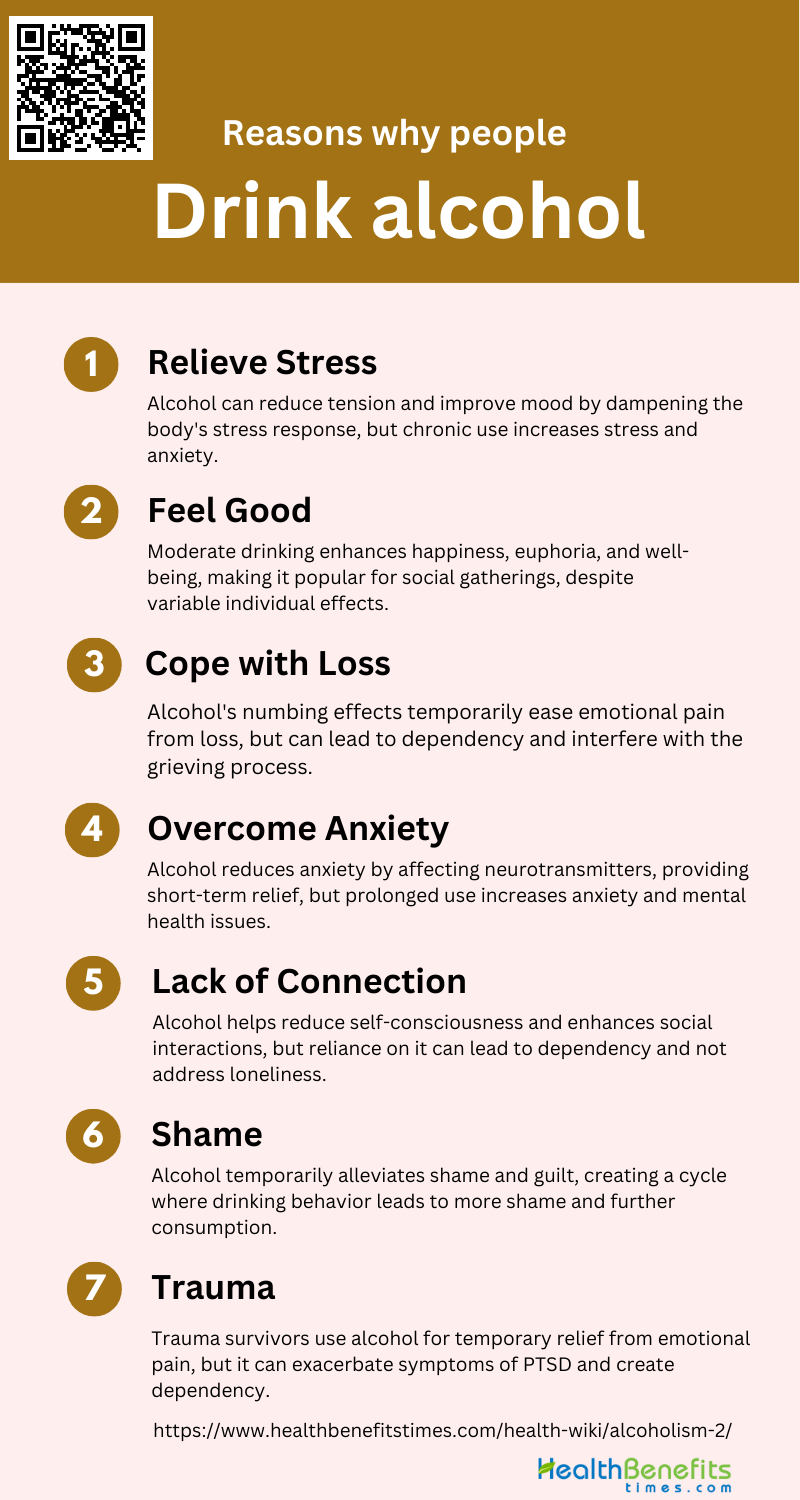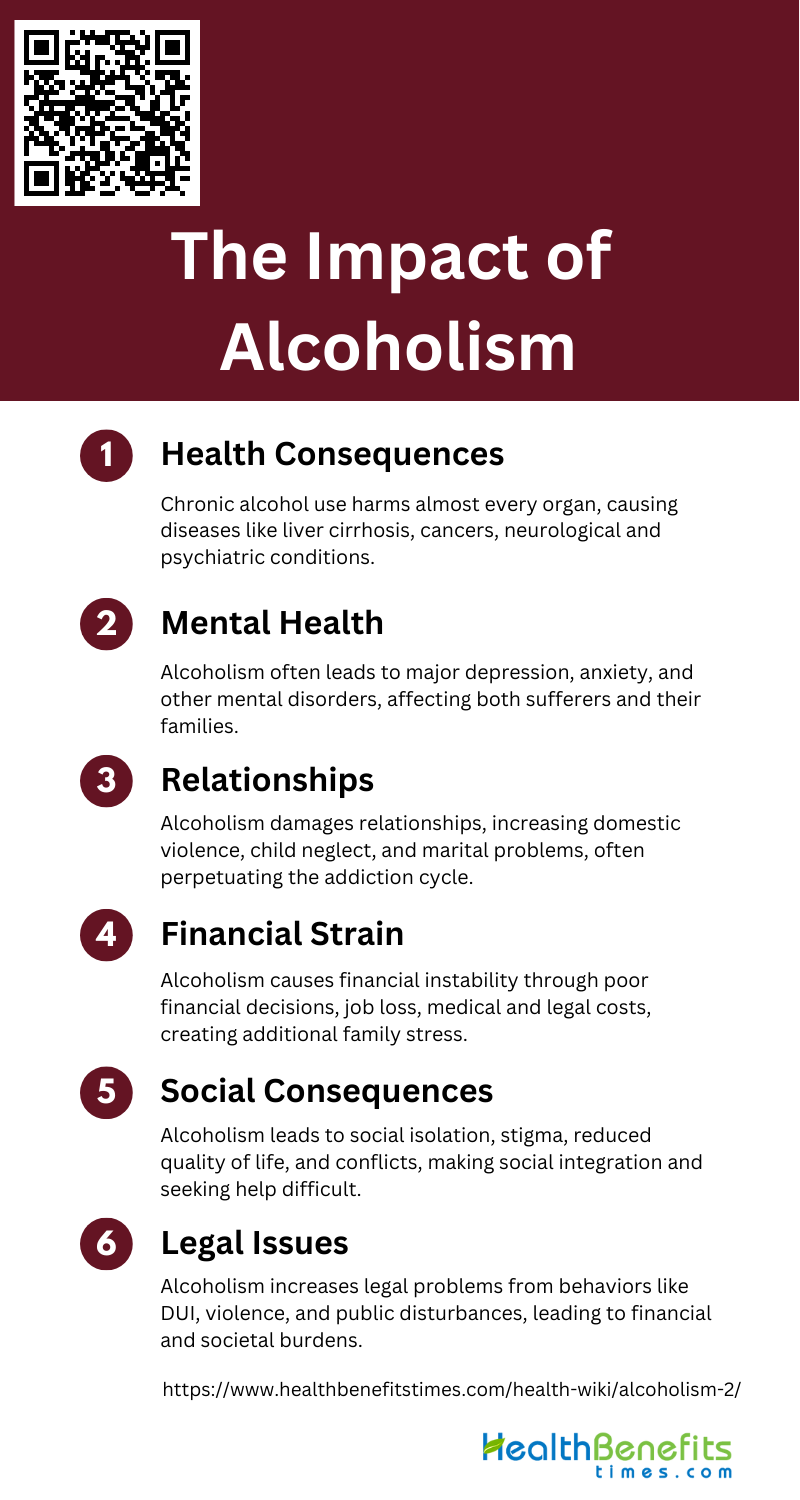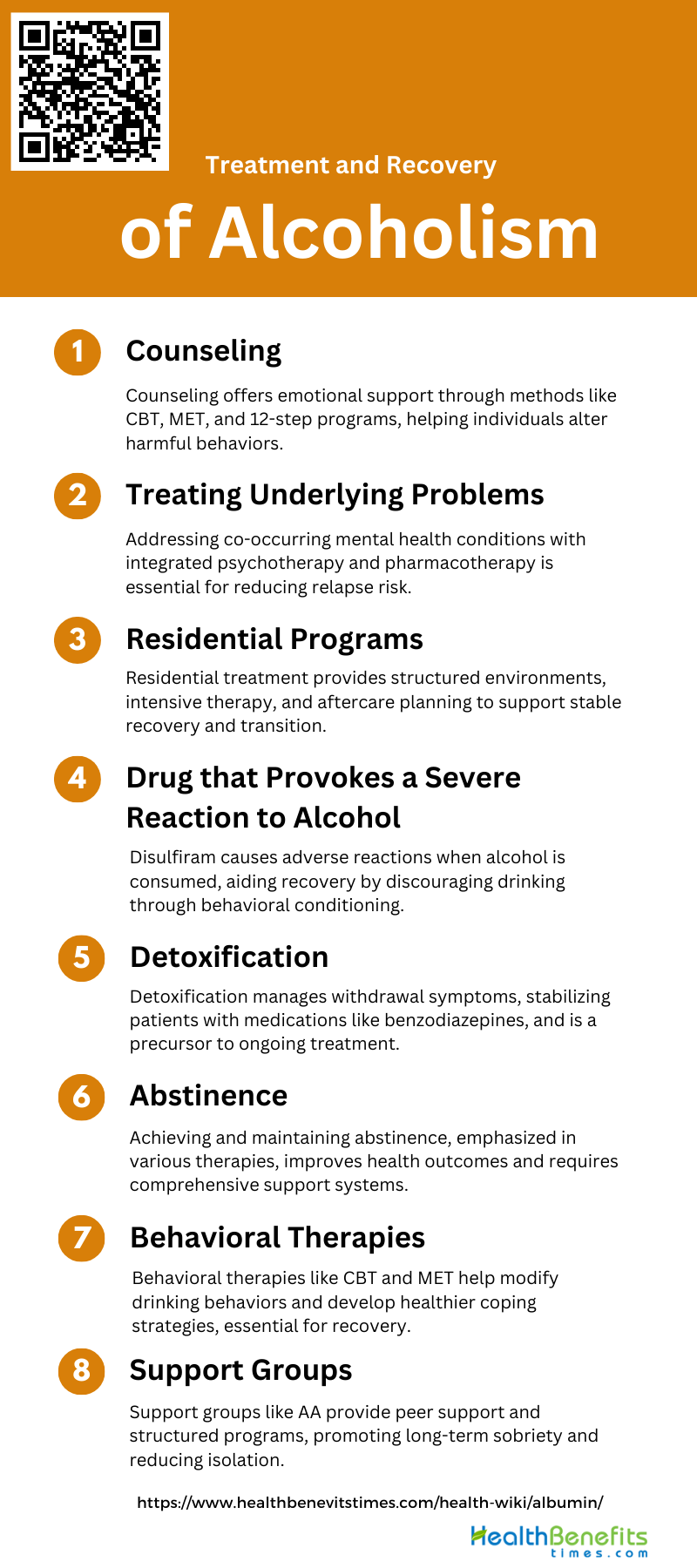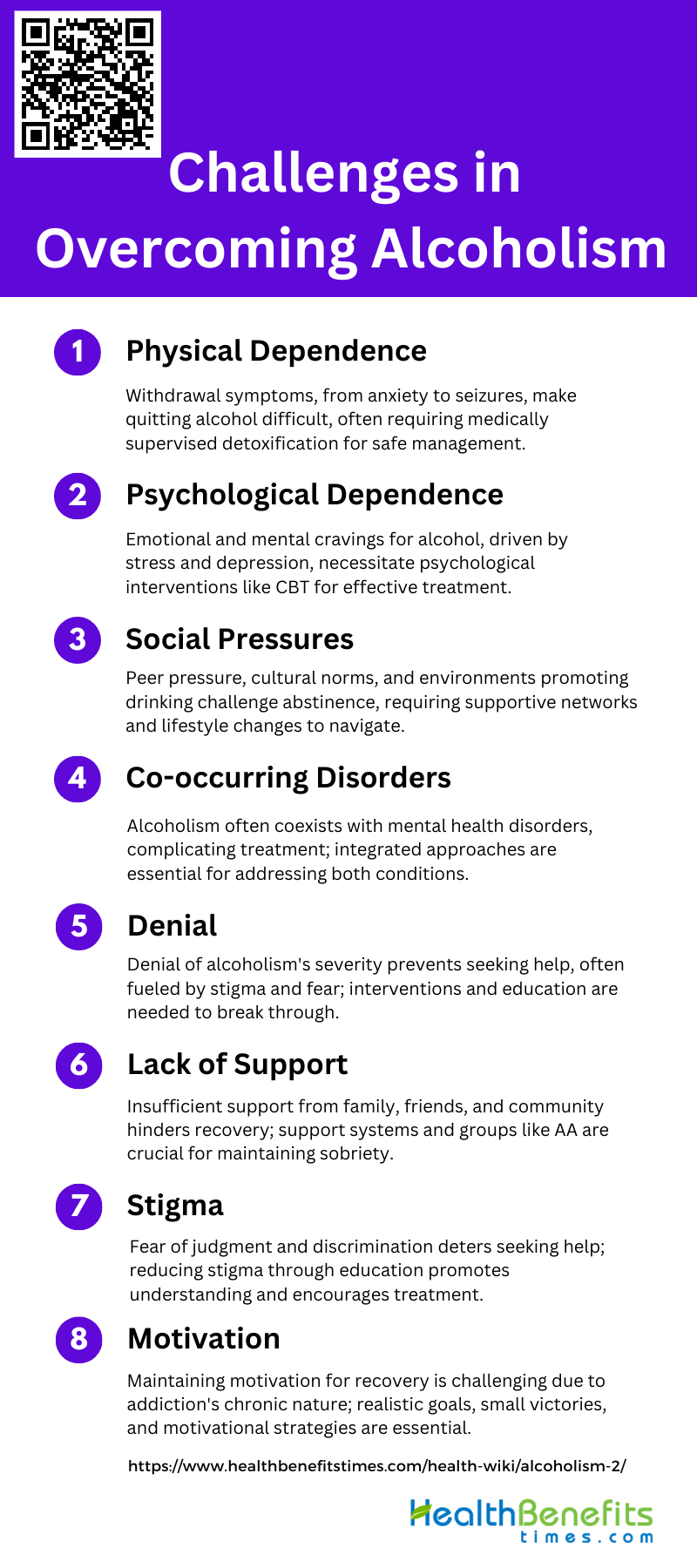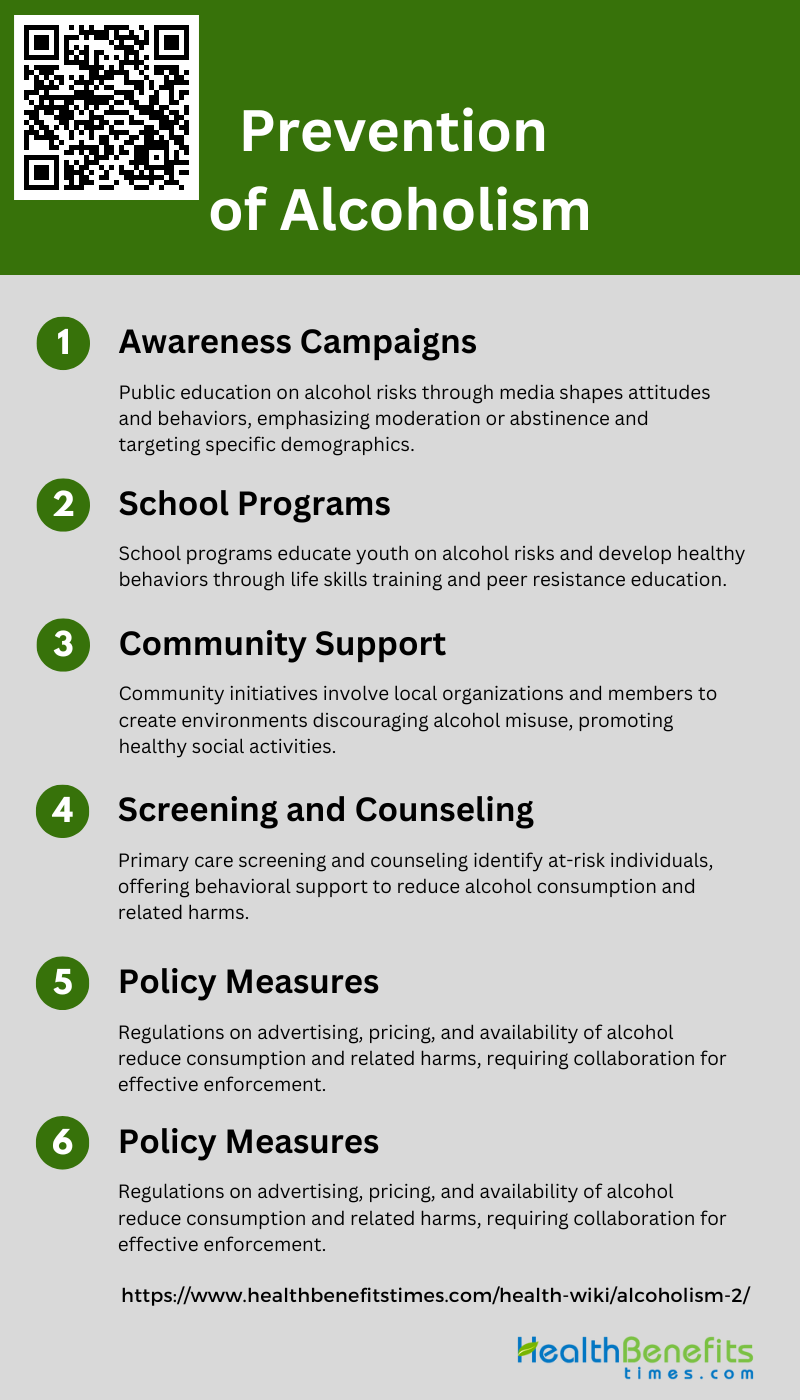 Alcoholism, also known as alcohol use disorder (AUD), is a chronic disease characterized by an inability to control alcohol consumption despite negative consequences. It involves a physical and psychological dependence on alcohol, leading to significant health, social, and functional impairments. Alcoholism can result in a range of adverse effects, including liver disease, cognitive deficits, and increased susceptibility to infections due to immune dysfunction. Genetic, environmental, and psychological factors contribute to the development of alcoholism, and it often coexists with other mental health disorders such as depression and anxiety. Treatment typically involves a combination of medical interventions, psychological therapies, and support systems to manage the condition and promote recovery.
Alcoholism, also known as alcohol use disorder (AUD), is a chronic disease characterized by an inability to control alcohol consumption despite negative consequences. It involves a physical and psychological dependence on alcohol, leading to significant health, social, and functional impairments. Alcoholism can result in a range of adverse effects, including liver disease, cognitive deficits, and increased susceptibility to infections due to immune dysfunction. Genetic, environmental, and psychological factors contribute to the development of alcoholism, and it often coexists with other mental health disorders such as depression and anxiety. Treatment typically involves a combination of medical interventions, psychological therapies, and support systems to manage the condition and promote recovery.
Understanding of Alcoholism
Understanding alcoholism requires a multifaceted approach that integrates various perspectives, including genetic, psychological, and sociocultural factors. Alcoholism is often described as a chronic relapsing disorder characterized by compulsive drinking, loss of control over alcohol intake, and significant impairment in social and occupational functioning. Genetic factors play a substantial role, accounting for more than 50% of the variance in alcoholism liability, with specific genes influencing vulnerability through their effects on neuronal pathways and stress resiliency. Psychological and behavioral aspects, such as personality traits and childhood influences, also significantly contribute to the onset and maintenance of alcohol use disorders. Moreover, the interaction between genetic predispositions and environmental factors, including cultural and social influences, further complicates the etiology of alcoholism. The complexity of alcoholism necessitates a systems-oriented perspective that considers the dynamic interplay of these factors over an individual’s lifespan. This comprehensive understanding is crucial for developing effective prevention and treatment strategies tailored to the diverse manifestations of this disorder.
Sign and symptoms of Alcoholism
Here are some common signs and symptoms:
1. Increased Tolerance: Needing more alcohol to feel its effects.
2. Withdrawal Symptoms: Shaking, sweating, nausea, insomnia, and anxiety when not drinking.
3. Inability to Control Drinking: Difficulty stopping or reducing alcohol consumption.
4. Neglecting Responsibilities: Failing to meet obligations at work, school, or home.
5. Strong Cravings: Intense urge or need to drink alcohol.
6. Preoccupation with Drinking: Constantly thinking about or planning to drink.
7. Health Issues: Developing liver disease, gastrointestinal problems, cardiovascular issues, or neurological damage.
8. Risky Behaviors: Engaging in dangerous activities such as drinking and driving.
9. Mood Swings: Experiencing irritability, depression, or anxiety related to drinking or its consequences.
Reasons why people drink alcohol
People drink alcohol for various reasons, and these can vary widely based on individual preferences, cultural contexts, and personal circumstances. Here are some common reasons:
1. Relieve Stress
People often drink alcohol to relieve stress, as it has been shown to reduce tension and improve mood when consumed in moderate amounts. Alcohol can dampen the body’s stress response, particularly by affecting the hypothalamic-pituitary-adrenal (HPA) axis, which regulates stress hormones like cortisol and adrenocorticotropic hormone (ACTH). This stress-relieving effect is one of the most commonly cited reasons for alcohol consumption. However, chronic alcohol use can disturb the neuroendocrine stress response system, potentially leading to increased stress and anxiety over time.
2. Feel Good
Alcohol consumption is often associated with positive emotional experiences. Moderate drinking can enhance feelings of happiness, euphoria, and overall well-being. It can increase affective expression and reduce feelings of tension, depression, and self-consciousness. These mood-enhancing properties make alcohol a popular choice for social gatherings and personal relaxation. However, the effects can vary significantly depending on individual differences and the context in which alcohol is consumed.
3. Cope with Loss
The numbing effects of alcohol can temporarily alleviate the emotional pain associated with losing a loved one or experiencing a significant life change. This coping strategy, however, can lead to dependency and exacerbate emotional distress in the long term. Chronic use of alcohol to cope with loss can also interfere with the natural grieving process, potentially leading to more severe mental health issues.
4. Overcome Anxiety
Many individuals turn to alcohol to manage anxiety. Alcohol has anxiolytic properties, meaning it can reduce anxiety and promote relaxation. This effect is partly due to alcohol’s impact on the central nervous system, where it influences neurotransmitters like GABA and serotonin, which are involved in regulating mood and anxiety. However, while alcohol may provide short-term relief, it can lead to increased anxiety and other mental health problems with prolonged use.
5. Lack of Connection
Feelings of social isolation and a lack of connection can drive people to drink alcohol. Alcohol is often used as a social lubricant, helping individuals feel more connected and less lonely in social settings. It can enhance social interactions by reducing self-consciousness and increasing feelings of conviviality and pleasantness. However, relying on alcohol for social connection can lead to dependency and may not address the underlying issues of loneliness and isolation.
6. Shame
Shame and guilt are powerful emotions that can lead individuals to seek solace in alcohol. Drinking can temporarily alleviate these feelings by numbing emotional pain and providing a sense of escape. However, this coping mechanism can create a vicious cycle, where the individual feels more shame and guilt about their drinking behavior, leading to further alcohol consumption. Addressing the root causes of shame and seeking healthier coping strategies is crucial for long-term well-being.
7. Trauma
Trauma survivors often use alcohol as a way to cope with the lingering effects of their experiences. Alcohol can provide temporary relief from the intrusive thoughts, flashbacks, and emotional pain associated with trauma. However, this can lead to a cycle of dependency and exacerbate the symptoms of post-traumatic stress disorder (PTSD) and other trauma-related conditions. Effective treatment for trauma often requires addressing both the psychological and substance use aspects of the individual’s experience.
The Impact of Alcoholism
Alcoholism, or alcohol use disorder (AUD), has profound effects on individuals, families, and society. Here are some key impacts:
1. Health Consequences
Alcoholism has severe health consequences, affecting nearly every organ system in the body. Chronic alcohol consumption is a major cause of mortality and is linked to numerous diseases, including liver cirrhosis, cardiovascular diseases, and various cancers such as those of the liver, breast, and digestive system. Additionally, alcohol dependence can lead to neurological impairments, including cognitive deficits and brain damage, as well as psychiatric conditions like depression, anxiety, and personality disorders. The toxicological effects of ethanol also contribute to malnutrition and immune system dysfunction, further exacerbating health issues.
2. Mental Health
Alcoholism significantly impacts mental health, often leading to psychiatric disorders such as major depression, anxiety disorders, and substance dependence. Chronic alcohol exposure disrupts brain reward and stress systems, resulting in a negative affective state characterized by dysphoria and anxiety. The psychological stress experienced by family members of alcoholics, including spouses and children, can also lead to high levels of depressive symptoms and other mental health issues. The mental health burden is compounded by the social stigma and isolation often associated with alcoholism.
3. Relationships
Alcoholism severely strains relationships, leading to increased domestic violence, child neglect, and marital discord. The aggressive and impulsive behaviors commonly exhibited by alcohol-dependent individuals contribute to interpersonal violence and deteriorating family dynamics. Spouses of alcoholics often experience significant psychological stress and may develop coping mechanisms that inadvertently enable the alcoholic’s behavior, perpetuating the cycle of addiction. The negative interactions and lack of support within the family can further exacerbate the situation, making it difficult to break the cycle of addiction.
4. Financial Strain
The financial strain caused by alcoholism is profound, affecting both the individual and their family. Alcohol-dependent individuals often make poor financial decisions, prioritizing alcohol over essential expenses, leading to financial instability and debt. The cost of alcohol, combined with potential job loss and decreased productivity, exacerbates financial difficulties. Families may also incur additional expenses related to medical treatments and legal issues stemming from alcohol-related incidents. The financial burden can lead to further stress and conflict within the family, creating a vicious cycle of financial and emotional strain.
5. Social Consequences
Alcoholism has far-reaching social consequences, including social isolation, stigma, and reduced quality of life. Alcohol-dependent individuals may struggle to maintain social relationships and fulfill social roles, leading to isolation and marginalization. The stigma associated with alcoholism can prevent individuals from seeking help, further entrenching them in their addiction. Additionally, alcohol-related behaviors, such as aggression and impaired judgment, can lead to social conflicts and legal issues, further alienating the individual from their social network.
6. Legal Issues
Legal issues are a common consequence of alcoholism, often resulting from alcohol-related behaviors such as driving under the influence, domestic violence, and public disturbances. Alcohol-dependent individuals are at a higher risk of engaging in criminal activities due to impaired judgment and increased impulsivity. Legal problems can lead to significant financial costs, including fines, legal fees, and potential incarceration. These legal issues not only affect the individual but also place a significant burden on their family and the broader community.
Treatment and Recovery of Alcoholism
Alcoholism is a complex and multifaceted disorder that requires a comprehensive approach to treatment and recovery. From traditional methods like cognitive behavioral therapy and 12-step programs to emerging interventions involving gut microbiota and psychedelics, the landscape of alcoholism treatment is continually evolving. Understanding the interplay of various therapeutic strategies is crucial for effective recovery.
1. Counseling
Counseling is a cornerstone in the treatment of alcoholism, providing emotional and psychological support to individuals struggling with alcohol dependence. Standard counseling approaches often emphasize abstinence and the use of 12-step programs, such as Alcoholics Anonymous (AA), which have been shown to be effective in promoting long-term recovery. Cognitive-behavioral therapy (CBT) and motivational enhancement therapy (MET) are also commonly used, helping patients to identify and change maladaptive thought patterns and behaviors associated with alcohol use. These therapies can be delivered in both individual and group settings, offering a supportive environment for patients to share their experiences and challenges.
2. Treating Underlying Problems
Addressing underlying psychological and emotional issues is crucial in the treatment of alcoholism. Many individuals with alcohol use disorder (AUD) also suffer from co-occurring mental health conditions such as depression, anxiety, or trauma-related disorders. Effective treatment plans often include a comprehensive assessment to identify these underlying problems, followed by integrated care that combines psychotherapy with pharmacotherapy when necessary. Medications such as antidepressants or anxiolytics may be prescribed to manage these co-occurring conditions, thereby reducing the risk of relapse and supporting overall mental health.
3. Residential Programs
Residential treatment programs provide a structured and supportive environment for individuals recovering from alcoholism. These programs typically involve a combination of detoxification, intensive therapy, and aftercare planning. Inpatient settings allow for close monitoring and immediate intervention in case of medical or psychological crises. Behavioral therapies, including aversion therapy and skills training, are often employed to help patients develop coping mechanisms and maintain abstinence. The goal is to stabilize the patient’s condition and prepare them for a successful transition back to their daily lives with ongoing support.
4. Drug that Provokes a Severe Reaction to Alcohol
Disulfiram (Antabuse) is a medication used to support the treatment of chronic alcoholism by provoking a severe reaction when alcohol is consumed. This aversive therapy works by inhibiting the enzyme acetaldehyde dehydrogenase, leading to the accumulation of acetaldehyde, which causes unpleasant symptoms such as nausea, vomiting, and headaches when alcohol is ingested. The use of disulfiram requires careful monitoring and a strong commitment from the patient, as the reaction can be severe. Behavioral contracting procedures are often used to increase compliance with this medication.
5. Detoxification
Detoxification is the initial step in the treatment of alcoholism, aimed at managing acute withdrawal symptoms and stabilizing the patient. This process can be conducted in both inpatient and outpatient settings, depending on the severity of the withdrawal symptoms and the presence of any co-occurring medical conditions. Medications such as benzodiazepines are commonly used to alleviate withdrawal symptoms and prevent complications such as seizures. Following detoxification, patients are typically referred to ongoing treatment programs to address the psychological aspects of addiction and prevent relapse.
6. Abstinence
Abstinence from alcohol is a primary goal in the treatment of alcoholism and is often emphasized in various therapeutic approaches, including 12-step programs and cognitive-behavioral therapy. Achieving and maintaining abstinence requires a comprehensive treatment plan that includes medical, psychological, and social support. Long-term abstinence is associated with improved health outcomes and quality of life. Support groups, ongoing counseling, and regular follow-up with healthcare providers are essential components of an abstinence-oriented care model.
7. Behavioral Therapies
Behavioral therapies play a significant role in the treatment of alcoholism by helping individuals change their drinking behaviors and develop healthier coping mechanisms. Cognitive-behavioral therapy (CBT) is one of the most effective approaches, focusing on identifying and modifying negative thought patterns and behaviors related to alcohol use. Motivational enhancement therapy (MET) is another effective approach that helps patients builds motivation to change their drinking habits. These therapies can be delivered in individual or group settings and are often integrated with other treatment modalities to provide comprehensive care.
8. Support Groups
Support groups, such as Alcoholics Anonymous (AA), provide a community-based approach to recovery, offering peer support and a structured program for maintaining sobriety. These groups operate on the principle of mutual aid, where individuals share their experiences and support each other in their recovery journey. The 12-step model used by AA has been shown to be effective in promoting long-term abstinence and improving overall quality of life. Participation in support groups can also reduce feelings of isolation and provide a sense of belonging, which is crucial for sustained recovery.
Challenges in Overcoming Alcoholism
Overcoming alcoholism is a multifaceted battle that extends beyond the physical dependencies to include psychological, social, and environmental hurdles. Each individual’s journey is unique, yet many face common challenges that can impede their path to sobriety. Here are several key obstacles that individuals often encounter in their fight against alcohol addiction:
1. Physical Dependence
Overcoming alcoholism is significantly challenged by physical dependence, which manifests through withdrawal symptoms when alcohol consumption is reduced or stopped. These symptoms can range from mild (e.g., anxiety, tremors) to severe (e.g., seizures, delirium tremens), making it difficult for individuals to quit without medical assistance. The body’s adaptation to chronic alcohol use alters brain chemistry, necessitating continued consumption to avoid discomfort. Effective management often requires a medically supervised detoxification process to safely navigate withdrawal and mitigate the risk of severe complications.
2. Psychological Dependence
Psychological dependence on alcohol involves a compulsive need to drink, driven by emotional and mental cravings. This form of dependence is rooted in the brain’s reward system, where alcohol use becomes a primary coping mechanism for stress, anxiety, or depression. The psychological grip of alcoholism can be profound, making it challenging for individuals to envision life without alcohol. Treatment often includes cognitive-behavioral therapy (CBT) and other psychological interventions to address underlying issues and develop healthier coping strategies.
3. Social Pressures
Social pressures play a critical role in the persistence of alcoholism. Peer pressure, cultural norms, and social environments that encourage drinking can make it difficult for individuals to abstain. Social gatherings, celebrations, and even professional settings may involve alcohol, creating constant temptations and reinforcing drinking behaviors. Addressing social pressures requires building a supportive network, learning to navigate social situations without alcohol, and sometimes making significant lifestyle changes to avoid high-risk environments.
4. Co-occurring Disorders
Many individuals with alcoholism also suffer from co-occurring mental health disorders, such as depression, anxiety, or bipolar disorder. These dual diagnoses complicate treatment, as both conditions need to be addressed simultaneously for effective recovery. Alcohol may be used as a form of self-medication, exacerbating mental health issues and creating a vicious cycle. Integrated treatment approaches that address both alcoholism and mental health disorders are essential for successful recovery.
5. Denial
Denial is a common barrier to overcoming alcoholism, as individuals may not recognize or admit the extent of their problem. This lack of acknowledgment can prevent them from seeking help and engaging in treatment. Denial can be fueled by stigma, fear of judgment, or a belief that they can control their drinking. Breaking through denial often requires interventions from loved ones, motivational interviewing, and education about the nature of addiction and its consequences.
6. Lack of Support
A lack of support from family, friends, and the community can hinder recovery from alcoholism. Support systems provide emotional encouragement, accountability, and practical assistance, which are crucial for maintaining sobriety. Without a strong support network, individuals may feel isolated and more likely to relapse. Support groups, such as Alcoholics Anonymous (AA), and family therapy can play vital roles in building a supportive environment conducive to recovery.
7. Stigma
Stigma surrounding alcoholism can deter individuals from seeking help due to fear of judgment and discrimination. This societal stigma can lead to feelings of shame and guilt, further entrenching the addiction. Overcoming stigma involves public education to change perceptions about alcoholism, promoting the understanding that it is a medical condition rather than a moral failing. Reducing stigma can encourage more people to seek treatment and support without fear of negative repercussions.
8. Motivation
Maintaining motivation for recovery is a significant challenge for individuals with alcoholism. The journey to sobriety is often long and fraught with setbacks, requiring sustained effort and commitment. Motivation can wane due to the chronic nature of addiction, the discomfort of withdrawal, and the lure of old habits. Enhancing motivation involves setting realistic goals, celebrating small victories, and finding personal reasons for staying sober. Motivational enhancement therapy (MET) and other motivational strategies can help individuals stay focused on their recovery journey.
Prevention and Education of Alcoholism
Alcoholism is a pervasive issue that can lead to devastating consequences for individuals, families, and communities. Effective prevention and education strategies are critical in mitigating the risks and spreading awareness about the dangers of excessive alcohol consumption. Here are several key approaches that have been identified to help prevent and educate about alcoholism:
1. Awareness Campaigns
Awareness campaigns are crucial in the prevention of alcoholism as they aim to educate the public about the risks associated with alcohol misuse. These campaigns often utilize various media platforms to disseminate information on the dangers of excessive drinking, the signs of alcohol dependence, and the benefits of moderation or abstinence. Research indicates that while awareness campaigns alone may not significantly reduce alcohol consumption, they play a vital role in shaping public attitudes and behaviors towards alcohol use. Effective campaigns often incorporate culturally relevant messages and target specific demographics to maximize their impact.
2. School Programs
School-based prevention programs are designed to educate young people about the risks of alcohol misuse and to develop skills that promote healthy behaviors. These programs often include components such as life skills training, peer resistance education, and information on the effects of alcohol. Studies have shown that certain school programs, like the Life Skills Training Program and the Good Behaviour Game, can be effective in reducing alcohol use among students. However, the effectiveness of these programs can vary, and ongoing research is needed to refine their content and delivery methods to ensure long-term success.
3. Community Support
Community support initiatives involve the collaboration of local organizations, healthcare providers, and community members to create a supportive environment that discourages alcohol misuse. These initiatives may include community-based education programs, support groups, and the promotion of healthy social activities. The Strengthening Families Program (SFP) has shown promise as an effective community-based intervention, particularly in reducing alcohol initiation behaviors among young people. Community support is essential for sustaining prevention efforts and providing individuals with the resources and encouragement needed to maintain healthy behaviors.
4. Screening and Counseling
Screening and counseling interventions in primary care settings are recommended to identify individuals at risk of alcohol misuse and provide them with appropriate support. The U.S. Preventive Services Task Force recommends that clinicians screen adults for alcohol misuse and offer brief behavioral counseling to those engaged in risky drinking. These interventions have been shown to be effective in reducing alcohol consumption and related harms. Techniques such as motivational interviewing and cognitive-behavioral therapy are commonly used to help individuals recognize the impact of their drinking and develop strategies for change.
5. Policy Measures
Policy measures play a critical role in the prevention of alcoholism by creating an environment that discourages excessive drinking. These measures can include regulations on alcohol advertising, pricing policies such as increased taxes on alcoholic beverages, and restrictions on the availability of alcohol. Evidence suggests that policy interventions can significantly reduce alcohol consumption and related harms at the population level. Effective policy measures require collaboration between government agencies, public health organizations, and communities to ensure comprehensive and enforceable regulations.
6. Family Education
Family education programs aim to address the familial factors that contribute to alcohol misuse and to support families in creating healthy home environments. These programs often involve family therapy and education on the genetic and environmental influences of alcoholism. Interventions that focus on improving family communication, setting clear expectations, and providing support for healthy behaviors have been shown to be effective in preventing alcohol misuse. The Strengthening Families Program is one example of a family-based intervention that has demonstrated long-term effectiveness in reducing alcohol use among young people. Family education is essential for breaking the cycle of alcohol dependence and promoting overall family well-being.


